Thanksgiving (United States)
from Wikipedia.org
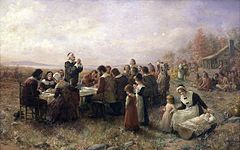 Thanksgiving is a federal holiday in the United States, celebrated on the fourth Thursday of November. It is sometimes called American Thanksgiving (outside the United States) to distinguish it from the Canadian holiday of the same name. It originated as a harvest festival, and to this day the centerpiece of Thanksgiving celebrations remains Thanksgiving dinner. The dinner traditionally consists of foods and dishes indigenous to the Americas, namely turkey, potatoes (usually mashed), stuffing, squash, corn (maize), green beans, cranberries (typically in sauce form), and pumpkin pie. Thanksgiving is regarded as being the beginning of the fall–winter holiday season, along with Christmas and the New Year, in American culture.
Thanksgiving is a federal holiday in the United States, celebrated on the fourth Thursday of November. It is sometimes called American Thanksgiving (outside the United States) to distinguish it from the Canadian holiday of the same name. It originated as a harvest festival, and to this day the centerpiece of Thanksgiving celebrations remains Thanksgiving dinner. The dinner traditionally consists of foods and dishes indigenous to the Americas, namely turkey, potatoes (usually mashed), stuffing, squash, corn (maize), green beans, cranberries (typically in sauce form), and pumpkin pie. Thanksgiving is regarded as being the beginning of the fall–winter holiday season, along with Christmas and the New Year, in American culture.
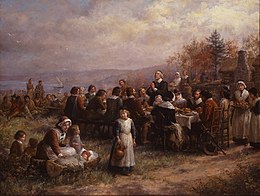 The event that Americans commonly call the "First Thanksgiving" was celebrated by the Pilgrims after their first harvest in the New World in October 1621. This feast lasted three days, and—as recounted by attendee Edward Winslow — was attended by 90 Native Americans and 53 Pilgrims. The New England colonists were accustomed to regularly celebrating "thanksgivings," days of prayer thanking God for blessings such as military victory or the end of a drought. Thanksgiving has been celebrated nationally on and off since 1789, with a proclamation by President George Washington after a request by Congress. President Thomas Jefferson chose not to observe the holiday, and its celebration was intermittent until President Abraham Lincoln, in 1863, proclaimed a national day of "Thanksgiving and Praise to our beneficent Father who dwelleth in the Heavens", to be celebrated on the last Thursday in November.
On June 28, 1870, President Ulysses S. Grant signed into law the Holidays Act that made Thanksgiving a yearly appointed federal holiday in Washington D.C. On January 6, 1885, an act by Congress made Thanksgiving, and other federal holidays, a paid holiday for all federal workers throughout the United States. Under President Franklin D. Roosevelt, the date was changed between 1939 and 1941 amid significant controversy. From 1942 onwards, Thanksgiving, by an act of Congress, signed into law by FDR, received a permanent observation date, the fourth Thursday in November, no longer at the discretion of the President.
History
The event that Americans commonly call the "First Thanksgiving" was celebrated by the Pilgrims after their first harvest in the New World in October 1621. This feast lasted three days, and—as recounted by attendee Edward Winslow — was attended by 90 Native Americans and 53 Pilgrims. The New England colonists were accustomed to regularly celebrating "thanksgivings," days of prayer thanking God for blessings such as military victory or the end of a drought. Thanksgiving has been celebrated nationally on and off since 1789, with a proclamation by President George Washington after a request by Congress. President Thomas Jefferson chose not to observe the holiday, and its celebration was intermittent until President Abraham Lincoln, in 1863, proclaimed a national day of "Thanksgiving and Praise to our beneficent Father who dwelleth in the Heavens", to be celebrated on the last Thursday in November.
On June 28, 1870, President Ulysses S. Grant signed into law the Holidays Act that made Thanksgiving a yearly appointed federal holiday in Washington D.C. On January 6, 1885, an act by Congress made Thanksgiving, and other federal holidays, a paid holiday for all federal workers throughout the United States. Under President Franklin D. Roosevelt, the date was changed between 1939 and 1941 amid significant controversy. From 1942 onwards, Thanksgiving, by an act of Congress, signed into law by FDR, received a permanent observation date, the fourth Thursday in November, no longer at the discretion of the President.
HistoryEarly thanksgiving observances Setting aside time to give thanks for one's blessings, along with holding feasts to celebrate a harvest, are both practices that long predate the European settlement of North America. The first documented thanksgiving services in territory currently belonging to the United States were conducted by Spaniards and the French in the 16th century.
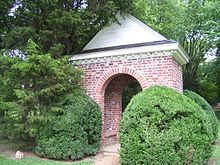 Thanksgiving services were routine in what became the Commonwealth of Virginia as early as 1607, with the first permanent settlement of Jamestown, Virginia holding a thanksgiving in 1610. In 1619, 38 English settlers arrived at Berkeley Hundred in Charles City County, Virginia. The group's London Company charter specifically required "that the day of our ships arrival at the place assigned ... in the land of Virginia shall be yearly and perpetually kept holy as a day of thanksgiving to Almighty God." Three years later, after the Indian massacre of 1622, the Berkeley Hundred site and other outlying locations were abandoned and colonists moved their celebration to Jamestown and other more secure spots.
Harvest festival observed by the Pilgrims at Plymouth
Thanksgiving services were routine in what became the Commonwealth of Virginia as early as 1607, with the first permanent settlement of Jamestown, Virginia holding a thanksgiving in 1610. In 1619, 38 English settlers arrived at Berkeley Hundred in Charles City County, Virginia. The group's London Company charter specifically required "that the day of our ships arrival at the place assigned ... in the land of Virginia shall be yearly and perpetually kept holy as a day of thanksgiving to Almighty God." Three years later, after the Indian massacre of 1622, the Berkeley Hundred site and other outlying locations were abandoned and colonists moved their celebration to Jamestown and other more secure spots.
Harvest festival observed by the Pilgrims at Plymouth
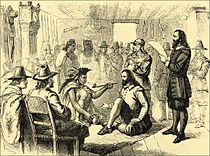 The most prominent historic thanksgiving event in American popular culture is the 1621 celebration at the Plymouth Plantation, where the settlers held a harvest feast after a successful growing season. Autumn or early winter feasts continued sporadically in later years, first as an impromptu religious observance and later as a civil tradition.
The Plymouth settlers, known as Pilgrims, had settled in land abandoned when all but one of the Patuxet Indians died in a disease outbreak. After a harsh winter killed half of the Plymouth settlers, the last surviving Patuxet, Tisquantum, more commonly known by the diminutive variant Squanto (who had learned English and avoided the plague as a slave in Europe), came in at the request of Samoset, the first Native American to encounter the Pilgrims. Squanto taught the Pilgrims how to catch eel and grow corn and served as an interpreter for them until he too succumbed to the disease a year later. The Wampanoag leader Massasoit also gave food to the colonists during the first winter when supplies brought from England were insufficient.
The Pilgrims celebrated at Plymouth for three days after their first harvest in 1621. The exact time is unknown, but James Baker, the Plimoth Plantation vice president of research, stated in 1996, "The event occurred between Sept. 21 and Nov. 11, 1621, with the most likely time being around Michaelmas (Sept. 29), the traditional time." Seventeenth-century accounts do not identify this as a Thanksgiving observance, rather it followed the harvest. It included 50 people who were on the Mayflower (all who remained of the 100 who had landed) and 90 Native Americans. The feast was cooked by the four adult Pilgrim women who survived their first winter in the New World (Eleanor Billington, Elizabeth Hopkins, Mary Brewster, and Susanna White), along with young daughters and male and female servants.
The most prominent historic thanksgiving event in American popular culture is the 1621 celebration at the Plymouth Plantation, where the settlers held a harvest feast after a successful growing season. Autumn or early winter feasts continued sporadically in later years, first as an impromptu religious observance and later as a civil tradition.
The Plymouth settlers, known as Pilgrims, had settled in land abandoned when all but one of the Patuxet Indians died in a disease outbreak. After a harsh winter killed half of the Plymouth settlers, the last surviving Patuxet, Tisquantum, more commonly known by the diminutive variant Squanto (who had learned English and avoided the plague as a slave in Europe), came in at the request of Samoset, the first Native American to encounter the Pilgrims. Squanto taught the Pilgrims how to catch eel and grow corn and served as an interpreter for them until he too succumbed to the disease a year later. The Wampanoag leader Massasoit also gave food to the colonists during the first winter when supplies brought from England were insufficient.
The Pilgrims celebrated at Plymouth for three days after their first harvest in 1621. The exact time is unknown, but James Baker, the Plimoth Plantation vice president of research, stated in 1996, "The event occurred between Sept. 21 and Nov. 11, 1621, with the most likely time being around Michaelmas (Sept. 29), the traditional time." Seventeenth-century accounts do not identify this as a Thanksgiving observance, rather it followed the harvest. It included 50 people who were on the Mayflower (all who remained of the 100 who had landed) and 90 Native Americans. The feast was cooked by the four adult Pilgrim women who survived their first winter in the New World (Eleanor Billington, Elizabeth Hopkins, Mary Brewster, and Susanna White), along with young daughters and male and female servants.
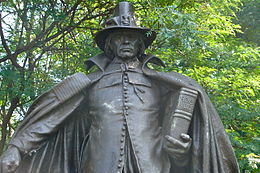 Two colonists gave personal accounts of the 1621 feast in Plymouth. The Pilgrims, most of whom were Separatists (English Dissenters), are not to be confused with Puritans, who established their own Massachusetts Bay Colony on the Shawmut Peninsula (current day Boston) in 1630. Both groups were strict Calvinists, but differed in their views regarding the Church of England. Puritans wished to remain in the Anglican Church and reform it, while the Pilgrims wanted complete separation from the church.
William Bradford, in Of Plymouth Plantation wrote:
Two colonists gave personal accounts of the 1621 feast in Plymouth. The Pilgrims, most of whom were Separatists (English Dissenters), are not to be confused with Puritans, who established their own Massachusetts Bay Colony on the Shawmut Peninsula (current day Boston) in 1630. Both groups were strict Calvinists, but differed in their views regarding the Church of England. Puritans wished to remain in the Anglican Church and reform it, while the Pilgrims wanted complete separation from the church.
William Bradford, in Of Plymouth Plantation wrote:
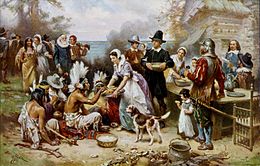 They began now to gather in the small harvest they had, and to fit up their houses and dwellings against winter, being all well recovered in health and strength and had all things in good plenty. For as some were thus employed in affairs abroad, others were exercised in fishing, about cod and bass and other fish, of which they took good store, of which every family had their portion. All the summer there was no want; and now began to come in store of fowl, as winter approached, of which this place did abound when they can be used (but afterward decreased by degrees). And besides waterfowl, there was great store of wild turkeys, of which they took many, besides venison, etc. Besides, they had about a peck a meal a week to a person, or now since harvest, Indian corn to the proportion. Which made many afterward write so largely of their plenty here to their friends in England, which were not feigned but true reports.
They began now to gather in the small harvest they had, and to fit up their houses and dwellings against winter, being all well recovered in health and strength and had all things in good plenty. For as some were thus employed in affairs abroad, others were exercised in fishing, about cod and bass and other fish, of which they took good store, of which every family had their portion. All the summer there was no want; and now began to come in store of fowl, as winter approached, of which this place did abound when they can be used (but afterward decreased by degrees). And besides waterfowl, there was great store of wild turkeys, of which they took many, besides venison, etc. Besides, they had about a peck a meal a week to a person, or now since harvest, Indian corn to the proportion. Which made many afterward write so largely of their plenty here to their friends in England, which were not feigned but true reports.
Our harvest being gotten in, our governor sent four men on fowling, that so we might after a special manner rejoice together after we had gathered the fruits of our labor. They four in one day killed as much fowl as, with a little help beside, served the company almost a week. At which time, amongst other recreations, we exercised our arms, many of the Indians coming amongst us, and among the rest their greatest king Massasoit, with some ninety men, whom for three days we entertained and feasted, and they went out and killed five deer, which we brought to the plantation and bestowed on our governor, and upon the captain and others. And although it be not always so plentiful as it was at this time with us, yet by the goodness of God, we are so far from want that we often wish you, partakers of our plenty.
The Pilgrims held a true Thanksgiving celebration in 1623 following a fast and a refreshing 14-day rain, which resulted in a larger harvest. William DeLoss Love calculates that this thanksgiving was made on Wednesday, July 30, 1623, a day before the arrival of a supply ship with more colonists, but before the fall harvest. In Love's opinion this 1623 thanksgiving was significant because the order to recognize the event was from civil authority (Governor Bradford), and not from the church, making it likely the first civil recognition of Thanksgiving in New England.
Referring to the 1623 harvest after the nearly catastrophic drought, Bradford wrote:
And afterward the Lord sent them such seasonable showers, with the interchange of fair warm weather as, through His blessing, caused a fruitful and liberal harvest, to their no small comfort and rejoicing. For which mercy, in time convenient, they also set apart a day of thanksgiving ... By this time harvest was come, and instead of famine now God gave them plenty ... for which they blessed God. And the effect of their particular planting was well seen, for all had ... pretty well ... so as any general want or famine had not been amongst them since to this day.
These firsthand accounts do not appear to have contributed to the early development of the holiday. Bradford's "Of Plymouth Plantation" was not published until the 1850s. The booklet "Mourt's Relation" was summarized by other publications without the now-familiar thanksgiving story. By the eighteenth century, the original booklet appeared to be lost or forgotten; a copy was rediscovered in Philadelphia in 1820, with the first full reprinting in 1841. In a footnote the editor, Alexander Young, was the first person to identify the 1621 feast as the first Thanksgiving.
According to historian James Baker, debates over where any "first Thanksgiving" took place on modern American territory are a "tempest in a beanpot". Jeremy Bang claims, "Local boosters in Virginia, Florida, and Texas promote their own colonists, who (like many people getting off a boat) gave thanks for setting foot again on dry land." Baker claims, "the American holiday's true origin was the New England Calvinist Thanksgiving. Never coupled with a Sabbath meeting, the Puritan observances were special days set aside during the week for thanksgiving and praise in response to God's providence."
President John F. Kennedy issued Proclamation 3560 on November 5, 1963: "Over three centuries ago, our forefathers in Virginia and in Massachusetts, far from home in a lonely wilderness, set aside a time of thanksgiving. On the appointed day, they gave reverent thanks for their safety, for the health of their children, for the fertility of their fields, for the love which bound them together and for the faith which united them with their God."
The Revolutionary War
The First National Proclamation of Thanksgiving was given by the Continental Congress in 1777 from its temporary location in York, Pennsylvania, while the British occupied the national capital at Philadelphia. Delegate Samuel Adams created the first draft. Congress then adopted the final version:
For as much as it is the indispensable Duty of all Men to adore the superintending Providence of Almighty God; to acknowledge with Gratitude their Obligation to him for Benefits received, and to implore such farther Blessings as they stand in Need of: And it had pleased him in his abundant Mercy, not only to continue to us the innumerable Bounties of his common Providence; but also to smile upon us in the Prosecution of a just and necessary war, for the Defense and Establishment of our unalienable Rights and Liberties; particularly in that he hath been pleased, in so great a Measure, to prosper the Means used for the Support of our Troops, and to crown our Arms with most signal success:
It is therefore recommended to the legislative or executive Powers of these United States to set apart Thursday, the eighteenth Day of December next, for Solemn Thanksgiving and Praise: That at one Time and with one Voice, the good People may express the grateful Feelings of their Hearts, and consecrate themselves to the Service of their Divine Benefactor; and that, together with their sincere Acknowledgments and Offerings, they may join the penitent Confession of their manifold Sins, whereby they had forfeited every Favor; and their humble and earnest Supplication that it may please God through the Merits of Jesus Christ, mercifully to forgive and blot them out of Remembrance; That it may please him graciously to afford his Blessing on the Governments of these States respectively, and prosper the public Council of the whole: To inspire our Commanders, both by Land and Sea, and all under them, with that Wisdom and Fortitude which may render them fit Instruments, under the Providence of Almighty God, to secure for these United States, the greatest of all human Blessings, Independence and Peace: That it may please him, to prosper the Trade and Manufactures of the People, and the Labor of the Husbandman, that our Land may yield its Increase: To take Schools and Seminaries of Education, so necessary for cultivating the Principles of true Liberty, Virtue and Piety, under his nurturing Hand; and to prosper the Means of Religion, for the promotion and enlargement of that Kingdom, which consisteth "in Righteousness, Peace and Joy in the Holy Ghost.
And it is further recommended, That servile Labor, and such Recreation, as, though at other Times innocent, may be unbecoming the Purpose of this Appointment, be omitted on so solemn an Occasion.
George Washington, leader of the revolutionary forces in the American Revolutionary War, proclaimed a Thanksgiving in December 1777 as a victory celebration honoring the defeat of the British at Saratoga.
Thanksgiving proclamations in the early Republic
The Continental Congress, the legislative body that governed the United States from 1774 to 1789, issued several "national days of prayer, humiliation, and thanksgiving", a practice that was continued by presidents Washington and Adams under the Constitution, and has manifested itself in the established American observances of Thanksgiving and the National Day of Prayer today. This proclamation was published in The Independent Gazetteer, or the Chronicle of Freedom, on November 5, 1782, the first being observed on November 28, 1782:
By the United States in Congress assembled, PROCLAMATION.
It being the indispensable duty of all nations, not only to offer up their supplications to Almighty God, the giver of all good, for His gracious assistance in a time of distress, but also in a solemn and public manner, to give Him praise for His goodness in general, and especially for great and signal interpositions of His Providence in their behalf; therefore, the United States in Congress assembled, taking into their consideration the many instances of Divine goodness to these States in the course of the important conflict, in which they have been so long engaged; the present happy and promising state of public affairs, and the events of the war in the course of the year now drawing to a close; particularly the harmony of the public Councils which is so necessary to the success of the public cause; the perfect union and good understanding which has hitherto subsisted between them and their allies, notwithstanding the artful and unwearied attempts of the common enemy to divide them; the success of the arms of the United States and those of their allies; and the acknowledgment of their Independence by another European power, whose friendship and commerce must be of great and lasting advantage to these States; Do hereby recommend it to the inhabitants of these States in general, to observe and request the several states to interpose their authority, in appointing and commanding the observation of THURSDAY the TWENTY-EIGHTH DAY OF NOVEMBER next as a day of SOLEMN THANKSGIVING to GOD for all His mercies; and they do further recommend to all ranks to testify their gratitude to God for His goodness by a cheerful obedience to His laws and by promoting, each in his station, and by his influence, the practice of true and undefiled religion, which is the great foundation of public prosperity and national happiness.
Done in Congress at Philadelphia, the eleventh day of October, in the year of our LORD, one thousand seven hundred and eighty-two, and of our Sovereignty and Independence, the seventh.
JOHN HANSON, President. CHARLES THOMSON, Secretary.
On Thursday, September 24, 1789, the first House of Representatives voted to recommend the First Amendment of the newly drafted Constitution to the states for ratification. The next day, Congressman Elias Boudinot from New Jersey proposed that the House and Senate jointly request of President Washington to proclaim a day of thanksgiving for "the many signal favors of Almighty God". Boudinot said he "could not think of letting the session pass over without offering an opportunity to all the citizens of the United States of joining, with one voice, in returning to Almighty God their sincere thanks for the many blessings he had poured down upon them."
As President, on October 3, 1789, George Washington made the following proclamation and created the first Thanksgiving Day designated by the national government of the United States of America:
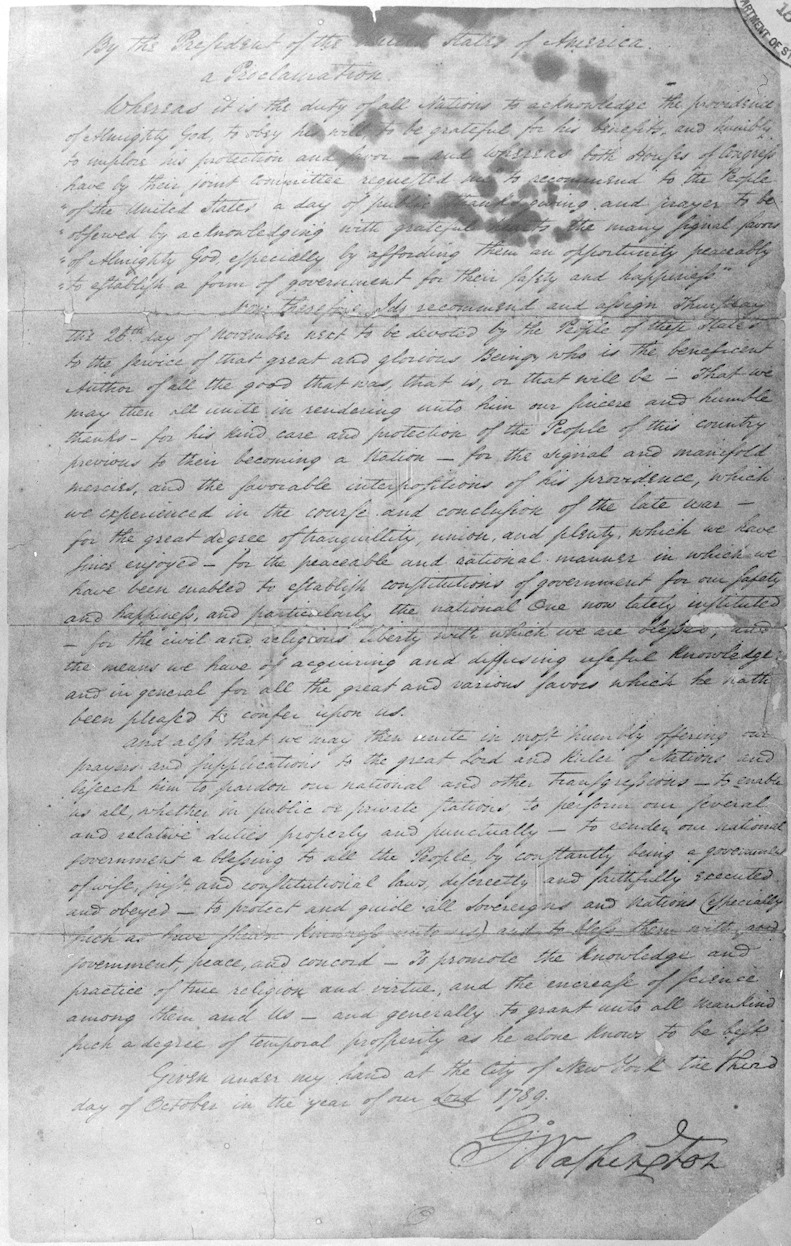 Whereas it is the duty of all Nations to acknowledge the providence of Almighty God, to obey his will, to be grateful for his benefits, and humbly to implore his protection and favor, and whereas both Houses of Congress have by their joint Committee requested me "to recommend to the People of the United States a day of public thanksgiving and prayer to be observed by acknowledging with grateful hearts the many signal favors of Almighty God especially by affording them an opportunity peaceably to establish a form of government for their safety and happiness."
Now therefore I do recommend and assign Thursday the 26th day of November next to be devoted by the People of these States to the service of that great and glorious Being, who is the beneficent Author of all the good that was, that is, or that will be. That we may then all unite in rendering unto him our sincere and humble thanks, for his kind care and protection of the People of this Country previous to their becoming a Nation, for the signal and manifold mercies, and the favorable interpositions of his providence, which we experienced in the course and conclusion of the late war, for the great degree of tranquility, union, and plenty, which we have since enjoyed, for the peaceable and rational manner, in which we have been enabled to establish constitutions of government for our safety and happiness, and particularly the national One now lately instituted, for the civil and religious liberty with which we are blessed; and the means we have of acquiring and diffusing useful knowledge; and in general for all the great and various favors which he hath been pleased to confer upon us.
And also that we may then unite in most humbly offering our prayers and supplications to the great Lord and Ruler of Nations and beseech him to pardon our national and other transgressions, to enable us all, whether in public or private stations, to perform our several and relative duties properly and punctually, to render our national government a blessing to all the people, by constantly being a Government of wise, just, and constitutional laws, discreetly and faithfully executed and obeyed, to protect and guide all Sovereigns and Nations (especially such as have shown kindness unto us) and to bless them with good government, peace, and concord. To promote the knowledge and practice of true religion and virtue, and the increase of science among them and Us, and generally to grant unto all Mankind such a degree of temporal prosperity as he alone knows to be best.
Given under my hand at the City of New York the third day of October in the year of our Lord 1789.
Whereas it is the duty of all Nations to acknowledge the providence of Almighty God, to obey his will, to be grateful for his benefits, and humbly to implore his protection and favor, and whereas both Houses of Congress have by their joint Committee requested me "to recommend to the People of the United States a day of public thanksgiving and prayer to be observed by acknowledging with grateful hearts the many signal favors of Almighty God especially by affording them an opportunity peaceably to establish a form of government for their safety and happiness."
Now therefore I do recommend and assign Thursday the 26th day of November next to be devoted by the People of these States to the service of that great and glorious Being, who is the beneficent Author of all the good that was, that is, or that will be. That we may then all unite in rendering unto him our sincere and humble thanks, for his kind care and protection of the People of this Country previous to their becoming a Nation, for the signal and manifold mercies, and the favorable interpositions of his providence, which we experienced in the course and conclusion of the late war, for the great degree of tranquility, union, and plenty, which we have since enjoyed, for the peaceable and rational manner, in which we have been enabled to establish constitutions of government for our safety and happiness, and particularly the national One now lately instituted, for the civil and religious liberty with which we are blessed; and the means we have of acquiring and diffusing useful knowledge; and in general for all the great and various favors which he hath been pleased to confer upon us.
And also that we may then unite in most humbly offering our prayers and supplications to the great Lord and Ruler of Nations and beseech him to pardon our national and other transgressions, to enable us all, whether in public or private stations, to perform our several and relative duties properly and punctually, to render our national government a blessing to all the people, by constantly being a Government of wise, just, and constitutional laws, discreetly and faithfully executed and obeyed, to protect and guide all Sovereigns and Nations (especially such as have shown kindness unto us) and to bless them with good government, peace, and concord. To promote the knowledge and practice of true religion and virtue, and the increase of science among them and Us, and generally to grant unto all Mankind such a degree of temporal prosperity as he alone knows to be best.
Given under my hand at the City of New York the third day of October in the year of our Lord 1789.
The year that is drawing towards its close has been filled with the blessings of fruitful fields and healthful skies. To these bounties, which are so constantly enjoyed that we are prone to forget the source from which they come, others have been added, which are of so extraordinary nature, that they cannot fail to penetrate and soften even the heart which is habitually insensible to the ever-watchful providence of Almighty God. In the midst of a civil war of unequaled magnitude and severity, which has sometimes seemed to foreign States to invite and to provoke their aggression, peace has been preserved with all nations, the order has been maintained, the laws have been respected and obeyed, and harmony has prevailed everywhere except in the theatre of military conflict; while that theatre has been greatly contracted by the advancing armies and navies of the Union. Needful diversions of wealth and of strength from the fields of peaceful industry to the national defense have not arrested the plow, the shuttle, or the ship; the ax had enlarged the borders of our settlements, and the mines, as well of iron and coal as of the precious metals, have yielded even more abundantly than heretofore. The population has steadily increased, notwithstanding the waste that has been made in the camp, the siege, and the battle-field; and the country, rejoicing in the consciousness of augmented strength and vigor, is permitted to expect continuance of years, with large increase of freedom. No human counsel hath devised nor hath any mortal hand worked out these great things. They are the gracious gifts of the Highest God, who, while dealing with us in anger for our sins, hath nevertheless remembered mercy.
It has seemed to me fit and proper that they should be solemnly, reverently and gratefully acknowledged as with one heart and voice by the whole American people. I do therefore invite my fellow-citizens in every part of the United States, and also those who are at sea and those who are sojourning in foreign lands, to set apart and observe the last Thursday of November next, as a day of Thanksgiving and Praise to our beneficent Father who dwelleth in the Heavens. And I recommend to them that while offering up the ascriptions justly due to Him for such singular deliverances and blessings, they do also, with humble penitence for our national perverseness and disobedience, commend to his tender care all those who have become widows, orphans, mourners or sufferers in the lamentable civil strife in which we are unavoidably engaged, and fervently implore the interposition of the Almighty Hand to heal the wounds of the nation and to restore it as soon as may be consistent with the Divine purposes to the full enjoyment of peace, harmony, tranquility and Union. In testimony whereof, I have hereunto set my hand, and caused the seal of the United States to be affixed. Done at the city of Washington, this third day of October, in the year of our Lord one thousand eight hundred and sixty-three, and of the independence of the United States the eighty-eighth. Proclamation of President Abraham Lincoln, October 3, 1863.
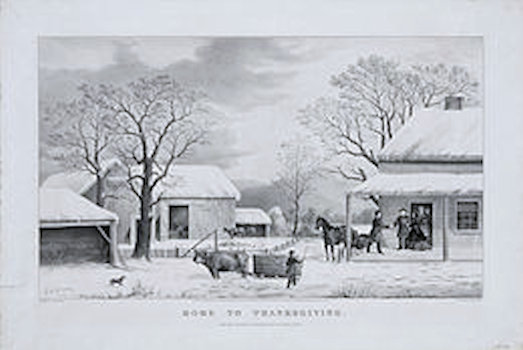 Since 1863, Thanksgiving has been observed annually in the United States. The holiday superseded Evacuation Day, a de facto national holiday that had been held on November 25 each year prior to the Civil War and commemorated the British withdrawal from the United States after the American Revolution.
Post-Civil War era
On June 28, 1870, President Ulysses S. Grant signed into law the Holidays Act that made Thanksgiving a yearly "appointed or remembered" federal holiday in Washington D.C. Three other holidays included in the law were New Years, Christmas, and the 4th of July. The law did not extend outside of Washington D.C., while the date assigned for Thanksgiving was left to the discretion of the President. In January 1879, George Washington's Birthday, February 22, was added by Congress to the federal holidays list. On January 6, 1885, a Congressional act expanded the Holidays Act to apply to all federal departments and employees throughout the nation. Federal workers received pay for all the holidays, including Thanksgiving.
During the second half of the 19th century, Thanksgiving traditions in America varied from region to region. A traditional New England Thanksgiving, for example, consisted of a raffle held on Thanksgiving Eve (in which the prizes were mainly geese or turkeys), a shooting match on Thanksgiving morning (in which turkeys and chickens were used as targets), church services—and then the traditional feast, which consisted of some familiar Thanksgiving staples such as turkey and pumpkin pie, and some not-so-familiar dishes such as pigeon pie. The earliest high school football rivalries took root in the late 19th century in Massachusetts, stemming from games played on Thanksgiving; professional football took root as a Thanksgiving staple during the sport's genesis in the 1890s, and the tradition of Thanksgiving football both at the high school and professional level continues to this day. The Southern United States had long resisted adopting the holiday before largely accepting it with the increased influence of football on the day.
In New York City, people would dress up in fanciful masks and costumes and roam the streets in merry-making mobs. By the beginning of the 20th century, these mobs had morphed into Ragamuffin parades consisting mostly of children dressed as "ragamuffins" in costumes of old and mismatched adult clothes and with deliberately smudged faces, but by the late 1950s the tradition had diminished enough to only exist in its original form in a few communities around New York, with many of its traditions subsumed into the Halloween custom of trick-or-treating.
1939 to 1941
Abraham Lincoln's successors as president followed his example of annually declaring the final Thursday in November to be Thanksgiving. But in 1939, President Franklin D. Roosevelt broke with this tradition. November had five Thursdays that year (instead of the more-common four), Roosevelt declared the fourth Thursday as Thanksgiving rather than the fifth one. Although many popular histories state otherwise, he made clear that his plan was to establish the holiday on the next-to-last Thursday in the month instead of the last one. With the country still in the midst of The Great Depression, Roosevelt thought an earlier Thanksgiving would give merchants a longer period to sell goods before Christmas. Increasing profits and spending during this period, Roosevelt hoped, would help bring the country out of the Depression. At the time, advertising goods for Christmas before Thanksgiving was considered inappropriate. Fred Lazarus, Jr., founder of the Federated Department Stores (later Macy's), is credited with convincing Roosevelt to push Thanksgiving to a week earlier to expand the shopping season, and within two years the change passed through Congress into law.
Republicans decried the change, calling it an affront to the memory of Lincoln. People began referring to November 30 as the "Republican Thanksgiving" and November 23 as the "Democratic Thanksgiving" or "Franksgiving". Regardless of the politics, many localities had made a tradition of celebrating on the last Thursday, and many football teams had a tradition of playing their final games of the season on Thanksgiving; with their schedules set well in advance, they could not change. Since a presidential declaration of Thanksgiving Day was not legally binding, Roosevelt's change was widely disregarded. Twenty-three states went along with Roosevelt's recommendation, 22 did not, and some, like Texas, could not decide and took both days as government holidays.
In 1940 and 1941, years in which November had four Thursdays, Roosevelt declared the third one as Thanksgiving. As in 1939, some states went along with the change while others retained the traditional last-Thursday date.
1942 to present
Since 1863, Thanksgiving has been observed annually in the United States. The holiday superseded Evacuation Day, a de facto national holiday that had been held on November 25 each year prior to the Civil War and commemorated the British withdrawal from the United States after the American Revolution.
Post-Civil War era
On June 28, 1870, President Ulysses S. Grant signed into law the Holidays Act that made Thanksgiving a yearly "appointed or remembered" federal holiday in Washington D.C. Three other holidays included in the law were New Years, Christmas, and the 4th of July. The law did not extend outside of Washington D.C., while the date assigned for Thanksgiving was left to the discretion of the President. In January 1879, George Washington's Birthday, February 22, was added by Congress to the federal holidays list. On January 6, 1885, a Congressional act expanded the Holidays Act to apply to all federal departments and employees throughout the nation. Federal workers received pay for all the holidays, including Thanksgiving.
During the second half of the 19th century, Thanksgiving traditions in America varied from region to region. A traditional New England Thanksgiving, for example, consisted of a raffle held on Thanksgiving Eve (in which the prizes were mainly geese or turkeys), a shooting match on Thanksgiving morning (in which turkeys and chickens were used as targets), church services—and then the traditional feast, which consisted of some familiar Thanksgiving staples such as turkey and pumpkin pie, and some not-so-familiar dishes such as pigeon pie. The earliest high school football rivalries took root in the late 19th century in Massachusetts, stemming from games played on Thanksgiving; professional football took root as a Thanksgiving staple during the sport's genesis in the 1890s, and the tradition of Thanksgiving football both at the high school and professional level continues to this day. The Southern United States had long resisted adopting the holiday before largely accepting it with the increased influence of football on the day.
In New York City, people would dress up in fanciful masks and costumes and roam the streets in merry-making mobs. By the beginning of the 20th century, these mobs had morphed into Ragamuffin parades consisting mostly of children dressed as "ragamuffins" in costumes of old and mismatched adult clothes and with deliberately smudged faces, but by the late 1950s the tradition had diminished enough to only exist in its original form in a few communities around New York, with many of its traditions subsumed into the Halloween custom of trick-or-treating.
1939 to 1941
Abraham Lincoln's successors as president followed his example of annually declaring the final Thursday in November to be Thanksgiving. But in 1939, President Franklin D. Roosevelt broke with this tradition. November had five Thursdays that year (instead of the more-common four), Roosevelt declared the fourth Thursday as Thanksgiving rather than the fifth one. Although many popular histories state otherwise, he made clear that his plan was to establish the holiday on the next-to-last Thursday in the month instead of the last one. With the country still in the midst of The Great Depression, Roosevelt thought an earlier Thanksgiving would give merchants a longer period to sell goods before Christmas. Increasing profits and spending during this period, Roosevelt hoped, would help bring the country out of the Depression. At the time, advertising goods for Christmas before Thanksgiving was considered inappropriate. Fred Lazarus, Jr., founder of the Federated Department Stores (later Macy's), is credited with convincing Roosevelt to push Thanksgiving to a week earlier to expand the shopping season, and within two years the change passed through Congress into law.
Republicans decried the change, calling it an affront to the memory of Lincoln. People began referring to November 30 as the "Republican Thanksgiving" and November 23 as the "Democratic Thanksgiving" or "Franksgiving". Regardless of the politics, many localities had made a tradition of celebrating on the last Thursday, and many football teams had a tradition of playing their final games of the season on Thanksgiving; with their schedules set well in advance, they could not change. Since a presidential declaration of Thanksgiving Day was not legally binding, Roosevelt's change was widely disregarded. Twenty-three states went along with Roosevelt's recommendation, 22 did not, and some, like Texas, could not decide and took both days as government holidays.
In 1940 and 1941, years in which November had four Thursdays, Roosevelt declared the third one as Thanksgiving. As in 1939, some states went along with the change while others retained the traditional last-Thursday date.
1942 to present
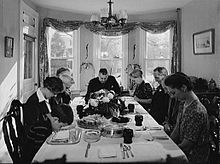 On October 6, 1941, both houses of the U.S. Congress passed a joint resolution fixing the traditional last-Thursday date for the holiday beginning in 1942. However, in December of that year the Senate passed an amendment to the resolution that split the difference by requiring that Thanksgiving be observed annually on the fourth Thursday of November, which was usually the last Thursday and sometimes (two years out of seven, on average) the penultimate. The amendment also passed the House, and on December 26, 1941, President Roosevelt signed this bill, for the first time making the date of Thanksgiving a matter of federal law and fixing the day as the fourth Thursday of November.
For several years some states continued to observe the last-Thursday date in years with five November Thursdays (the next such year being 1944), with Texas doing so as late as 1956.
Traditional celebrations
On October 6, 1941, both houses of the U.S. Congress passed a joint resolution fixing the traditional last-Thursday date for the holiday beginning in 1942. However, in December of that year the Senate passed an amendment to the resolution that split the difference by requiring that Thanksgiving be observed annually on the fourth Thursday of November, which was usually the last Thursday and sometimes (two years out of seven, on average) the penultimate. The amendment also passed the House, and on December 26, 1941, President Roosevelt signed this bill, for the first time making the date of Thanksgiving a matter of federal law and fixing the day as the fourth Thursday of November.
For several years some states continued to observe the last-Thursday date in years with five November Thursdays (the next such year being 1944), with Texas doing so as late as 1956.
Traditional celebrations
Charity
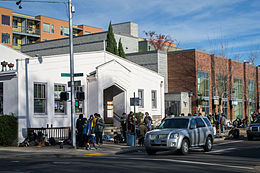 Hungry diners line up outside a performing arts center for a free Thanksgiving meal in Eugene, Oregon, in 2013
The poor are often provided with food at Thanksgiving time. Most communities have annual food drives that collect non-perishable packaged and canned foods, and corporations sponsor charitable distributions of staple foods and Thanksgiving dinners. The Salvation Army enlists volunteers to serve Thanksgiving dinners to hundreds of people in different locales. Additionally, pegged to be five days after Thanksgiving is Giving Tuesday, a celebration of charitable giving.
Foods of the season
U.S. tradition compares the holiday with a meal held in 1621 by the Wampanoag and the Pilgrims who settled at Plymouth Plantation. It is continued in modern times with the Thanksgiving dinner, traditionally featuring turkey, playing a central role in the celebration of Thanksgiving.
In the United States, certain kinds of food are traditionally served at Thanksgiving meals. Turkey, usually roasted and stuffed (but sometimes deep-fried instead), is typically the featured item on most Thanksgiving feast tables, so much so that Thanksgiving is also colloquially known as "Turkey Day". In fact, 45 million turkeys were consumed on Thanksgiving Day alone in 2015. With 85 percent of Americans partaking in the meal, an estimated 276 million Americans dine on the festive poultry, spending an expected $1.05 billion on turkeys for Thanksgiving in 2016.
Mashed potatoes with gravy, stuffing, sweet potatoes, cranberry sauce, sweet corn, various fall vegetables, squash, Brussels sprouts and pumpkin pie are among the side dishes commonly associated with Thanksgiving dinner. Green bean casserole was introduced in 1955 and remains a favorite. All these are actually native to the Americas or were introduced as a new food source to the Europeans when they arrived. Turkey may be an exception. In his book Mayflower, Nathaniel Philbrick suggests that the Pilgrims might already have been familiar with turkey in England, even though the bird is native to the Americas. The Spaniards had brought domesticated turkeys back from Central America in the early 17th century, and the birds soon became popular fare all over Europe, including England, where turkey (as an alternative to the traditional goose) became a "fixture at English Christmases". The Pilgrims did not observe Christmas, as they could find no evidence in the scriptures as to when such a holiday should be celebrated and felt its December scheduling was a spurious Roman Catholic invention.
As a result of the size of Thanksgiving dinner, Americans eat more food on Thanksgiving than on any other day of the year.
Giving thanks
Hungry diners line up outside a performing arts center for a free Thanksgiving meal in Eugene, Oregon, in 2013
The poor are often provided with food at Thanksgiving time. Most communities have annual food drives that collect non-perishable packaged and canned foods, and corporations sponsor charitable distributions of staple foods and Thanksgiving dinners. The Salvation Army enlists volunteers to serve Thanksgiving dinners to hundreds of people in different locales. Additionally, pegged to be five days after Thanksgiving is Giving Tuesday, a celebration of charitable giving.
Foods of the season
U.S. tradition compares the holiday with a meal held in 1621 by the Wampanoag and the Pilgrims who settled at Plymouth Plantation. It is continued in modern times with the Thanksgiving dinner, traditionally featuring turkey, playing a central role in the celebration of Thanksgiving.
In the United States, certain kinds of food are traditionally served at Thanksgiving meals. Turkey, usually roasted and stuffed (but sometimes deep-fried instead), is typically the featured item on most Thanksgiving feast tables, so much so that Thanksgiving is also colloquially known as "Turkey Day". In fact, 45 million turkeys were consumed on Thanksgiving Day alone in 2015. With 85 percent of Americans partaking in the meal, an estimated 276 million Americans dine on the festive poultry, spending an expected $1.05 billion on turkeys for Thanksgiving in 2016.
Mashed potatoes with gravy, stuffing, sweet potatoes, cranberry sauce, sweet corn, various fall vegetables, squash, Brussels sprouts and pumpkin pie are among the side dishes commonly associated with Thanksgiving dinner. Green bean casserole was introduced in 1955 and remains a favorite. All these are actually native to the Americas or were introduced as a new food source to the Europeans when they arrived. Turkey may be an exception. In his book Mayflower, Nathaniel Philbrick suggests that the Pilgrims might already have been familiar with turkey in England, even though the bird is native to the Americas. The Spaniards had brought domesticated turkeys back from Central America in the early 17th century, and the birds soon became popular fare all over Europe, including England, where turkey (as an alternative to the traditional goose) became a "fixture at English Christmases". The Pilgrims did not observe Christmas, as they could find no evidence in the scriptures as to when such a holiday should be celebrated and felt its December scheduling was a spurious Roman Catholic invention.
As a result of the size of Thanksgiving dinner, Americans eat more food on Thanksgiving than on any other day of the year.
Giving thanks
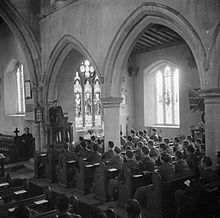 Thanksgiving was founded as a religious observance for all the members of the community to give thanks to God for a common purpose. A 1541 thanksgiving mass was held by the Spanish explorer Francisco Vásquez de Coronado and his expedition of 1,500 men at Palo Duro Canyon in what is today the Texas Panhandle. A thanksgiving took place after the victory in the 1777 Battle of Saratoga during the Revolutionary War. In his 1789 National Thanksgiving Proclamation, President Washington gave many noble reasons for a national Thanksgiving, including "for the civil and religious liberty", for "useful knowledge", and for God's "kind care" and "His Providence". After President Washington delivered this message, the "Episcopal Church, of which President Washington was a member, announced that the first Thursday in November would become its regular day for giving thanks".
The tradition of giving thanks to God is continued today in many forms, most notably the attendance of religious services, as well as the saying of a mealtime prayer before Thanksgiving dinner. Many houses of worship offer worship services and events on Thanksgiving themes the weekend before, the day of, or the weekend after Thanksgiving. At home, it is a holiday tradition in many families to begin the Thanksgiving dinner by saying grace (a prayer before or after a meal). The custom is portrayed in the photograph "Family Holding Hands and Praying Before a Thanksgiving Meal". Before praying, it is a common practice at the dining table for "each person [to] tell one specific reason they're thankful to God that year". While grace is said, some families hold hands until the prayer concludes, often indicated with an "Amen".
Joy Fisher, a Baptist writer, states that "this holiday takes on a spiritual emphasis and includes recognition of the source of the blessings they enjoy year round—a loving God." In the same vein, Hesham A. Hassaballa, an American Muslim scholar and physician, has written that Thanksgiving "is wholly consistent with Islamic principles" and that "few things are more Islamic than thanking God for His blessings". Similarly many Sikh Americans also celebrate the holiday by "giving thanks to Almighty".
Parades
Thanksgiving was founded as a religious observance for all the members of the community to give thanks to God for a common purpose. A 1541 thanksgiving mass was held by the Spanish explorer Francisco Vásquez de Coronado and his expedition of 1,500 men at Palo Duro Canyon in what is today the Texas Panhandle. A thanksgiving took place after the victory in the 1777 Battle of Saratoga during the Revolutionary War. In his 1789 National Thanksgiving Proclamation, President Washington gave many noble reasons for a national Thanksgiving, including "for the civil and religious liberty", for "useful knowledge", and for God's "kind care" and "His Providence". After President Washington delivered this message, the "Episcopal Church, of which President Washington was a member, announced that the first Thursday in November would become its regular day for giving thanks".
The tradition of giving thanks to God is continued today in many forms, most notably the attendance of religious services, as well as the saying of a mealtime prayer before Thanksgiving dinner. Many houses of worship offer worship services and events on Thanksgiving themes the weekend before, the day of, or the weekend after Thanksgiving. At home, it is a holiday tradition in many families to begin the Thanksgiving dinner by saying grace (a prayer before or after a meal). The custom is portrayed in the photograph "Family Holding Hands and Praying Before a Thanksgiving Meal". Before praying, it is a common practice at the dining table for "each person [to] tell one specific reason they're thankful to God that year". While grace is said, some families hold hands until the prayer concludes, often indicated with an "Amen".
Joy Fisher, a Baptist writer, states that "this holiday takes on a spiritual emphasis and includes recognition of the source of the blessings they enjoy year round—a loving God." In the same vein, Hesham A. Hassaballa, an American Muslim scholar and physician, has written that Thanksgiving "is wholly consistent with Islamic principles" and that "few things are more Islamic than thanking God for His blessings". Similarly many Sikh Americans also celebrate the holiday by "giving thanks to Almighty".
Parades
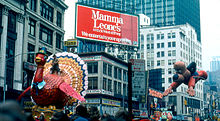 Since 1924, in New York City, the Macy's Thanksgiving Day Parade is held annually every Thanksgiving Day from the Upper West Side of Manhattan to Macy's flagship store in Herald Square, and televised nationally by NBC. The parade features parade floats with specific themes, performances from Broadway musicals, large balloons of cartoon characters, TV personalities, and high school marching bands. The float that traditionally ends the Macy's Parade is the Santa Claus float, the arrival of which is an unofficial sign of the beginning of the Christmas season. It is billed as the world's largest parade.
The oldest Thanksgiving Day parade is the Philadelphia's Thanksgiving Day Parade, which launched in 1920 and takes place in Philadelphia, Pennsylvania. Philadelphia's parade was long associated with Gimbels, a prominent Macy's rival, until that store closed in 1986. Its current sponsors are WPVI-TV, the channel 6 ABC affiliate in Philadelphia; and Dunkin' Donuts donut chain.
Founded in 1924, the same year as the Macy's parade, America's Thanksgiving Parade in Detroit is one of the largest parades in the country. The parade runs from Midtown to Downtown Detroit and precedes the annual Detroit Lions Thanksgiving football game. The parade includes large balloons, marching bands, and various celebrity guests much like the Macy's parade and is nationally televised on various affiliate stations. The Mayor of Detroit closes the parade by giving Santa Claus a key to the city.
Other Events
Many American cities hold road running events, known as "turkey trots", on Thanksgiving morning, so much so that as of 2018, Thanksgiving is the most popular race day in the U.S. Depending on the organizations involved, these can range from one-mile (1.6 km) fun runs to full marathons (although no races currently use the latter; the Atlanta Marathon stopped running on Thanksgiving in 2010). Most turkey trots range from between three and ten miles (5–16 km).
The world championship pumpkin chunking contest was held in early November in Delaware and televised each Thanksgiving on Science Channel, but a lawsuit arising from an injury suffered by one of the producers in the 2016 event caused the cancellation of the 2017 one.
Television
While not as prolific as Christmas specials, which usually begin right after Thanksgiving, there are many special television programs transmitted on or around Thanksgiving, such as A Charlie Brown Thanksgiving, in addition to the live parades and football games mentioned above. In some cases, television broadcasters begin programming Christmas films and specials to run on Thanksgiving Day, taking the day as a signal for the beginning of the Christmas season.
Turkey pardoning
Since 1924, in New York City, the Macy's Thanksgiving Day Parade is held annually every Thanksgiving Day from the Upper West Side of Manhattan to Macy's flagship store in Herald Square, and televised nationally by NBC. The parade features parade floats with specific themes, performances from Broadway musicals, large balloons of cartoon characters, TV personalities, and high school marching bands. The float that traditionally ends the Macy's Parade is the Santa Claus float, the arrival of which is an unofficial sign of the beginning of the Christmas season. It is billed as the world's largest parade.
The oldest Thanksgiving Day parade is the Philadelphia's Thanksgiving Day Parade, which launched in 1920 and takes place in Philadelphia, Pennsylvania. Philadelphia's parade was long associated with Gimbels, a prominent Macy's rival, until that store closed in 1986. Its current sponsors are WPVI-TV, the channel 6 ABC affiliate in Philadelphia; and Dunkin' Donuts donut chain.
Founded in 1924, the same year as the Macy's parade, America's Thanksgiving Parade in Detroit is one of the largest parades in the country. The parade runs from Midtown to Downtown Detroit and precedes the annual Detroit Lions Thanksgiving football game. The parade includes large balloons, marching bands, and various celebrity guests much like the Macy's parade and is nationally televised on various affiliate stations. The Mayor of Detroit closes the parade by giving Santa Claus a key to the city.
Other Events
Many American cities hold road running events, known as "turkey trots", on Thanksgiving morning, so much so that as of 2018, Thanksgiving is the most popular race day in the U.S. Depending on the organizations involved, these can range from one-mile (1.6 km) fun runs to full marathons (although no races currently use the latter; the Atlanta Marathon stopped running on Thanksgiving in 2010). Most turkey trots range from between three and ten miles (5–16 km).
The world championship pumpkin chunking contest was held in early November in Delaware and televised each Thanksgiving on Science Channel, but a lawsuit arising from an injury suffered by one of the producers in the 2016 event caused the cancellation of the 2017 one.
Television
While not as prolific as Christmas specials, which usually begin right after Thanksgiving, there are many special television programs transmitted on or around Thanksgiving, such as A Charlie Brown Thanksgiving, in addition to the live parades and football games mentioned above. In some cases, television broadcasters begin programming Christmas films and specials to run on Thanksgiving Day, taking the day as a signal for the beginning of the Christmas season.
Turkey pardoning
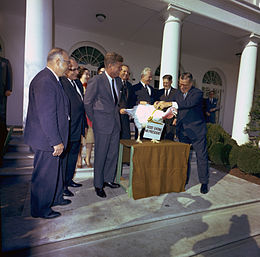 The practice of pardoning turkeys in this manner became a permanent tradition in 1989.
Since 1947, the National Turkey Federation has presented the President of the United States with one live turkey and two dressed turkeys, in a ceremony known as the National Thanksgiving Turkey Presentation. John F. Kennedy was the first president reported to spare the turkey given to him (he said he didn't plan to eat the bird), and Ronald Reagan was the first to grant the turkey a presidential pardon, which he jokingly presented to his 1987 turkey. The turkey was then sent to a petting zoo.
Some legends date the origins of pardoning turkey to the Harry Truman administration or even to Abraham Lincoln pardoning his son's Christmas turkey; both stories have been quoted in more recent presidential speeches, but neither has any evidence in the Presidential record. In more recent years, two turkeys have been pardoned, in case the original turkey becomes unavailable for presidential pardoning.
George H. W. Bush, who served as vice president under Reagan, made the turkey pardon a permanent annual tradition upon assuming the presidency in 1989, a tradition that has been carried on by every president each year since. The pardoned turkeys have typically ended up in the Northern Virginia suburbs of Washington, D.C. From 1989 to 2004 they were sent to a children's farm called Frying Pan Farm Park in Herndon, Virginia. From 2009 to 2013 they were sent to George Washington's Mount Vernon estate near Alexandria, Virginia, and in 2014 they were sent to an estate in Leesburg, Virginia once owned by former state governor and turkey farmer Westmoreland Davis. However, from 2005 to 2009 they were sent to either Walt Disney World or Disneyland. The turkeys rarely live to see the next Thanksgiving due to being bred for large size.
Days after Thanksgiving
The day after Thanksgiving is a holiday for some companies and most schools. In the last two decades of the 20th century, it became known as Black Friday, the beginning of the Christmas shopping season and a day for chaotic, early-morning sales at major retailers that were closed on Thanksgiving. A contrasting movement known as Buy Nothing Day originated in Canada in 1992. The day after Thanksgiving is also Native American Heritage Day, a day to pay tribute to Native Americans for their many contributions to the United States.
Small Business Saturday, a movement promoting shopping at smaller local establishments, takes place on the last Saturday in November, two days after Thanksgiving. Cyber Monday is a nickname given to the Monday following Thanksgiving; the day evolved in the early days of the Internet, when consumers returning to work took advantage of their employers' broadband Internet connections to do online shopping and retailers began offering sales to meet the demand. Giving Tuesday takes place on the Tuesday after Thanksgiving.
Criticism and controversy
The practice of pardoning turkeys in this manner became a permanent tradition in 1989.
Since 1947, the National Turkey Federation has presented the President of the United States with one live turkey and two dressed turkeys, in a ceremony known as the National Thanksgiving Turkey Presentation. John F. Kennedy was the first president reported to spare the turkey given to him (he said he didn't plan to eat the bird), and Ronald Reagan was the first to grant the turkey a presidential pardon, which he jokingly presented to his 1987 turkey. The turkey was then sent to a petting zoo.
Some legends date the origins of pardoning turkey to the Harry Truman administration or even to Abraham Lincoln pardoning his son's Christmas turkey; both stories have been quoted in more recent presidential speeches, but neither has any evidence in the Presidential record. In more recent years, two turkeys have been pardoned, in case the original turkey becomes unavailable for presidential pardoning.
George H. W. Bush, who served as vice president under Reagan, made the turkey pardon a permanent annual tradition upon assuming the presidency in 1989, a tradition that has been carried on by every president each year since. The pardoned turkeys have typically ended up in the Northern Virginia suburbs of Washington, D.C. From 1989 to 2004 they were sent to a children's farm called Frying Pan Farm Park in Herndon, Virginia. From 2009 to 2013 they were sent to George Washington's Mount Vernon estate near Alexandria, Virginia, and in 2014 they were sent to an estate in Leesburg, Virginia once owned by former state governor and turkey farmer Westmoreland Davis. However, from 2005 to 2009 they were sent to either Walt Disney World or Disneyland. The turkeys rarely live to see the next Thanksgiving due to being bred for large size.
Days after Thanksgiving
The day after Thanksgiving is a holiday for some companies and most schools. In the last two decades of the 20th century, it became known as Black Friday, the beginning of the Christmas shopping season and a day for chaotic, early-morning sales at major retailers that were closed on Thanksgiving. A contrasting movement known as Buy Nothing Day originated in Canada in 1992. The day after Thanksgiving is also Native American Heritage Day, a day to pay tribute to Native Americans for their many contributions to the United States.
Small Business Saturday, a movement promoting shopping at smaller local establishments, takes place on the last Saturday in November, two days after Thanksgiving. Cyber Monday is a nickname given to the Monday following Thanksgiving; the day evolved in the early days of the Internet, when consumers returning to work took advantage of their employers' broadband Internet connections to do online shopping and retailers began offering sales to meet the demand. Giving Tuesday takes place on the Tuesday after Thanksgiving.
Criticism and controversy
Much like Columbus Day, Thanksgiving is considered by some to be a "national day of mourning", as a celebration of the genocide and conquest of Native Americans by colonists. Thanksgiving has long carried a distinct resonance for Native Americans, who see the holiday as an embellished story of "Pilgrims and Natives looking past their differences" to break bread. Professor Dan Brook of the University of California, Berkeley condemns the "cultural and political amnesia" of Americans who celebrate Thanksgiving: "We do not have to feel guilty, but we do need to feel something." Professor Robert Jensen of the University of Texas at Austin is somewhat harsher: "One indication of moral progress in the United States would be the replacement of Thanksgiving Day and its self-indulgent family feasting with a National Day of Atonement accompanied by a self-reflective collective fasting." Some of the controversy regarding Thanksgiving has been used to justify the Christmas creep (the act of putting up Christmas decorations before Thanksgiving). Those who sympathize with this view acknowledge it as a small minority view; author and humanist John G. Rodwan, who does not celebrate Thanksgiving, noted "If you put forth the interpretation (...) that touches on the dishonorable treatment of the native population that lived in what became the United States, then you are likely to be dismissed as some sort of crank(.)" Since 1970, the United American Indians of New England, a protest group led by Frank "Wamsutta" James has accused the United States and European settlers of fabricating the Thanksgiving story and of whitewashing a genocide and injustice against Native Americans, and it has led a National Day of Mourning protest on Thanksgiving at Plymouth Rock in Plymouth, Massachusetts in the name of social equality and in honor of political prisoners. On November 27, 1969, as another notable example of anti-Thanksgiving sentiment, hundreds of supporters traveled to Alcatraz on Thanksgiving Day to celebrate the Occupation of Alcatraz (which had started a week earlier and lasted until 1971) by Native Americans of All Tribes. The American Indian Movement and the Native American Church (peyote religion) both also hold a negative view of Thanksgiving; the AIM has used it as a platform for protest, most notably when they took over a Mayflower float in a Thanksgiving Day parade. Some Native Americans hold "Unthanksgiving Day" celebrations in which they mourn the deaths of their ancestors, fast, dance, and pray. This tradition has been taking place since 1975.
.jpg) The perception of Thanksgiving among Native Americans is not, however, universally negative. Tim Giago, founder of the Native American Journalists Organization, seeks to reconcile Thanksgiving with Native American traditions. He compares Thanksgiving to "wopila", a thanks-giving celebration practiced by Native Americans of the Great Plains. He wrote in The Huffington Post: "The idea of a day of Thanksgiving has been a part of the Native American landscape for centuries. The fact that it is also a national holiday for all Americans blends in perfectly with Native American traditions." He also shares personal anecdotes of Native American families coming together to celebrate Thanksgiving. Members of the Oneida Indian Nation marched in the 2010 Macy's Thanksgiving Day Parade with a float called "The True Spirit of Thanksgiving" and have done so every year since.
The move by retailers to begin holiday sales during Thanksgiving Day (as opposed to the traditional day after) has been criticized as forcing (under threat of being fired) low-end retail workers, who compose an increasing share of the nation's workforce, to work odd hours and to handle atypical, unruly crowds on a day reserved for rest. In response to this controversy, Macy's and Best Buy (both of which planned to open on Thanksgiving, even earlier than they had the year before) stated in 2014 that most of their Thanksgiving Day shifts were filled voluntarily by employees who would rather have the day after Thanksgiving off instead of Thanksgiving itself. Blue laws in several Northeastern states prevent retailers in those states from opening on Thanksgiving. Such retailers typically open at midnight on the day after Thanksgiving to circumvent the laws as much as legally possible.
Journalist Edward R. Murrow and producer David Lowe deliberately chose Thanksgiving weekend 1960 to release Murrow's final story for CBS News. Entitled Harvest of Shame, the hour-long documentary was designed "to shock Americans into action" in regard to the treatment of impoverished migrant workers in the country, hoping to contrast Thanksgiving dinner and its excesses with the poverty of those who picked the vegetables. Murrow acknowledged the documentary portrayed the United States from a hostile perspective and, when he left CBS to join the United States Information Agency in 1961, unsuccessfully tried to stop the special from being aired in the United Kingdom.
The perception of Thanksgiving among Native Americans is not, however, universally negative. Tim Giago, founder of the Native American Journalists Organization, seeks to reconcile Thanksgiving with Native American traditions. He compares Thanksgiving to "wopila", a thanks-giving celebration practiced by Native Americans of the Great Plains. He wrote in The Huffington Post: "The idea of a day of Thanksgiving has been a part of the Native American landscape for centuries. The fact that it is also a national holiday for all Americans blends in perfectly with Native American traditions." He also shares personal anecdotes of Native American families coming together to celebrate Thanksgiving. Members of the Oneida Indian Nation marched in the 2010 Macy's Thanksgiving Day Parade with a float called "The True Spirit of Thanksgiving" and have done so every year since.
The move by retailers to begin holiday sales during Thanksgiving Day (as opposed to the traditional day after) has been criticized as forcing (under threat of being fired) low-end retail workers, who compose an increasing share of the nation's workforce, to work odd hours and to handle atypical, unruly crowds on a day reserved for rest. In response to this controversy, Macy's and Best Buy (both of which planned to open on Thanksgiving, even earlier than they had the year before) stated in 2014 that most of their Thanksgiving Day shifts were filled voluntarily by employees who would rather have the day after Thanksgiving off instead of Thanksgiving itself. Blue laws in several Northeastern states prevent retailers in those states from opening on Thanksgiving. Such retailers typically open at midnight on the day after Thanksgiving to circumvent the laws as much as legally possible.
Journalist Edward R. Murrow and producer David Lowe deliberately chose Thanksgiving weekend 1960 to release Murrow's final story for CBS News. Entitled Harvest of Shame, the hour-long documentary was designed "to shock Americans into action" in regard to the treatment of impoverished migrant workers in the country, hoping to contrast Thanksgiving dinner and its excesses with the poverty of those who picked the vegetables. Murrow acknowledged the documentary portrayed the United States from a hostile perspective and, when he left CBS to join the United States Information Agency in 1961, unsuccessfully tried to stop the special from being aired in the United Kingdom.